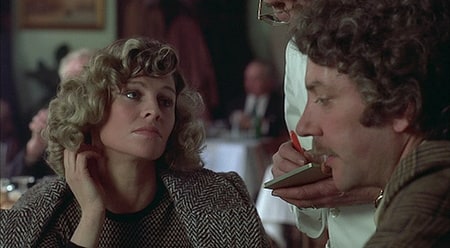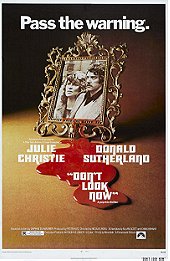Despite being decades old, Nicolas Roeg's Don't Look Now remains an uncompromisingly honest and staggeringly evocative motion picture which tackles the mysteries of life, death, fear, hope, love and grief. The movie stems from the pen of English writer Daphne du Maurier, whose works of literature are a rich source for filmmakers - her stories also formed the genesis for such Alfred Hitchcock movies as The Birds, Rebecca, and Jamaica Inn. While Don't Look Now is not quite of the calibre of Hitchcock's masterworks, Roeg succeeded in bringing to the screen the inherent eroticism that underpins Maurier's writing which starkly contrasts the fear and tension of her themes. In translating the film to the big screen, a few significant changes were made to Maurier's story, but the basic elements of the narrative remain in place.

As the story begins, it's a dreary afternoon for the Baxter family until young Christine Baxter falls into a nearby pond and drowns. An undisclosed amount of time later, John (Sutherland) and Laura (Christie) Baxter are in the Italian city of Venice while John assists in the renovation of a local 16th Century church which is in a state of disrepair. While having lunch together, Laura meets two elderly sisters - Heather (Mason) and Wendy (Matania) - at a restaurant, the former of which is a blind psychic who claims she saw Christine safe and happy in the afterlife. The information visibly renews Laura's psyche, and her demeanour improves dramatically. While initially sceptical and rather humoured by the event, John becomes increasingly disturbed as Laura obsesses about using the elderly sisters to communicate with Christine. When further messages reveal that their lives may be in grave danger, strange events begin to occur and John starts seeing a mysterious hooded girl, leading John to question whether the warnings may be for real.
The city of Venice was transformed into a character in itself here; mist-shrouded, labyrinthine and gloomy. The maze of streets seem to have been specifically designed to make unwary tourists lose their way, which in turn clouds John's consciousness; rendering him unable to figure out exactly what's happening. Don't Look Now is usually categorised as a horror film of the supernatural variety, but it's nothing conventional. There are no detectable poltergeists or spirits...or are there? Director Roeg possesses the canny ability to make the mundane appear sinister, and Don't Look Now is consequently a fiendish exercise in keeping the audience wondering what things are significant, what things are merely happenstance, and what things are genuine signs that something horrible is right around the corner. This is the type of film which demands repeat viewings, as it needs to be studied frame-by-frame to fully grasp how intricately it was assembled.

For Don't Look Now, Roeg and screenwriters Alan Scott and Chris Bryant set up a maze of subtle clues and suggestions which match the ominous labyrinth of alleyways, bridges, canals and streets which populate the Venice setting. Throughout the film, events from the past and the present intersect, often leaving you unsure as to whether you're seeing a flashback, a flash-forward, or an event taking place in the present. While this works on one level to build tension, it works thematically as well due to the fact that the film is primarily concerned with the uncertainty of time. This theme is underscored by the numerous scenes in which characters arrive too late. Augmenting all of this is Roeg's direction - he managed to build a powerful sense of impending doom throughout. Don't Look Now is not the type of movie which relies on cheap thrills or exploitation elements to see it through.
Anthony Richmond's cinematography and lighting is superbly atmospheric; painting the autumnal months in Venice with a spookily drab yet realistic colour palette. The colour red continually pops up throughout the film to symbolise two diverse things: memories of Christine, and possible threats toiling in the mundane. Due to the colours being so deliberately muted, red stands out each time it appears. However, there's a great deal of symbolism throughout which grows increasingly heavy-handed and is too thickly ladled on. As a result, the film feels meandering. This is the type of movie that film students spend hours dissecting and writing thesis papers on, but this does not necessarily mean it is always entertaining. On the contrary, in fact - Don't Look Now would've been superior and more effective if only it had been more direct. Fortunately, the wait is almost worth it for the finale, which is absolutely unforgettable.

As John and Laura Baxter, Donald Sutherland and Julie Christie are utterly remarkable; essaying a married couple who never feel anything less than authentic. A sex scene between the two is breathtakingly intimate, and their love-making is interspersed with subdued snapshots of them preparing to go out for dinner. For years, rumours have circulated that Sutherland and Christie got carried away and actually did the sexual deed on-camera. Roeg has insisted this is not true, but it's easy to understand how the rumour got started - the scene is incredibly erotic, honest and raw in a way that's rarely seen in films anymore.
Despite the film's meandering nature, Don't Look Now for the most part sustains a high level of tension through brilliant characterisation, white-knuckle set-pieces, and a constant fear of the unseen that's seriously unnerving. Hollywood simply does not produce thrillers of this calibre anymore.
7.3/10
 Login
Login